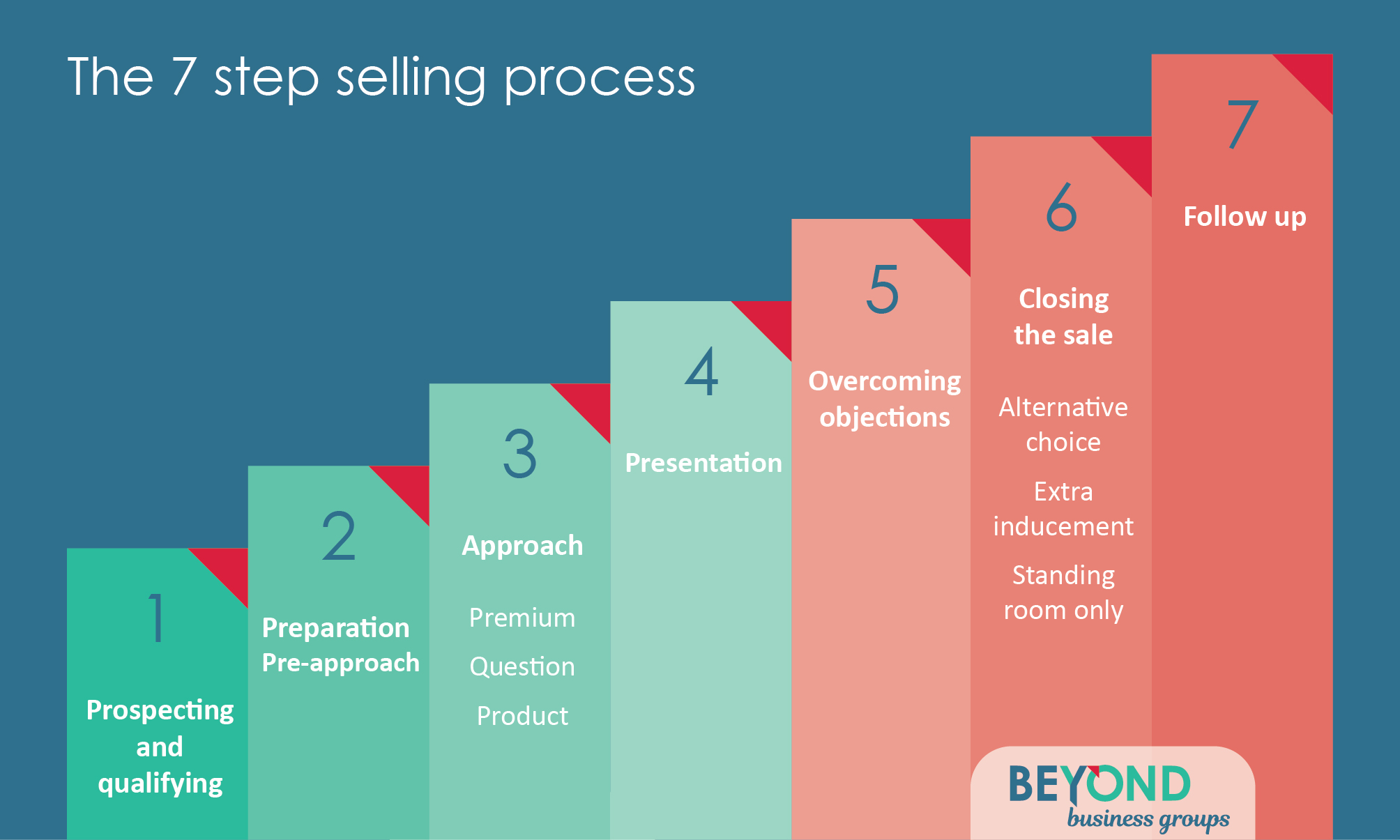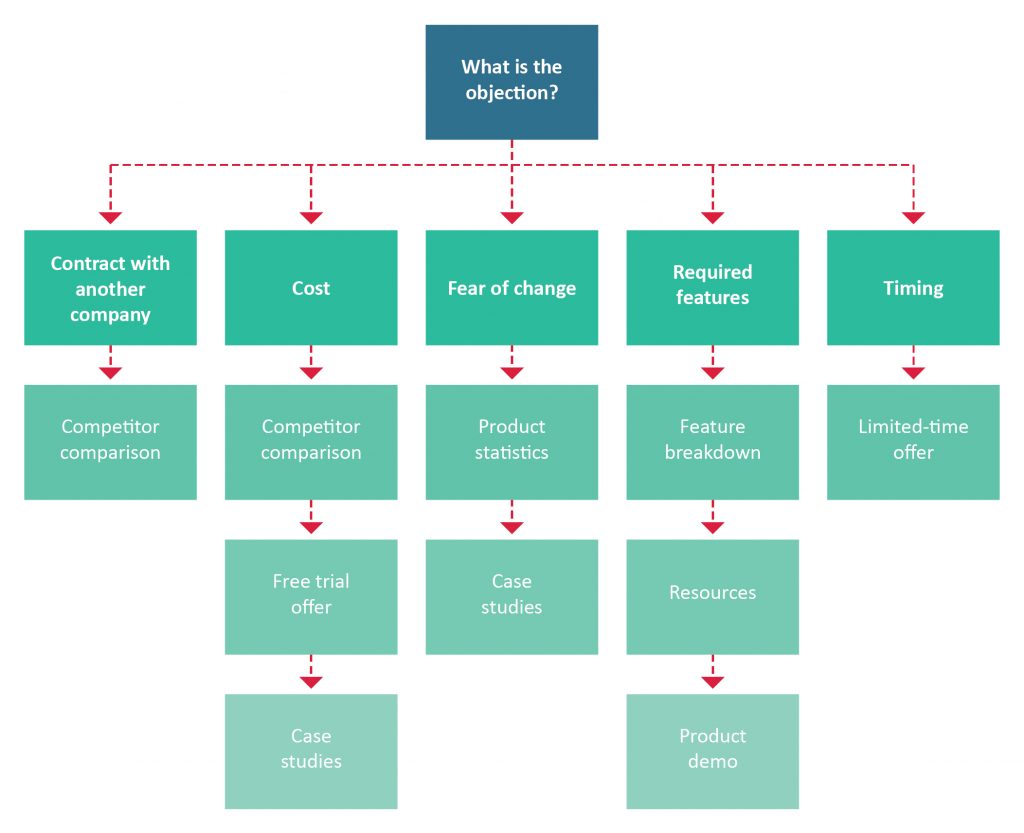
15 Sep The 7 step selling process
I have been studying scriptwriting and one of the most incredible realisations during the course was how most movie scripts, regardless of the genre, follow the same basic formula – the same sequence of events – almost down to the minute. Now I can see how the same sequence of events applies to the Lion King as it does to Avengers, I can’t watch movies the same way anymore!
This is a little like the selling process. We have been researching selling for our Beyond Business Groups modules, hoping for a contemporary twist on selling that may be different from what I learned at The Body Shop all those years ago. But it seems the same 7 step selling process, originally developed some one hundred years ago, still applies today regardless of the product or service being sold!
What has changed
While the sales process is adaptive depending on the situation, the simple but logical framework of seven steps remains the same, even as the methods of communication and the way people interact with brands has changed substantially. What has changed is how each of the steps can involve much more collaboration between customers and salespeople (and even between customers) with the use of social networks, consumer reviews, wikis and other community-based tools. In theory, this should make the sales process even easier as technology allows you and your sales team to learn more about your target market at each step. This means you can provide more relevant and powerful solutions to your customers at each stage of the buying process.
Combining your knowledge of your target market together with an understanding of the seven steps to sales will help you sell more to the people who want what you’ve got the most! If you are a retailer, wholesaler, work business to business (B2B), are a service provider or online store, there are tips and tricks you can take from the 7 step selling process to create your own sales and communications activities within the seven steps sequence.
As the old adage goes, ‘Learn the rules like a pro so you can break them like an artist.’
The 7 steps
The 7 step selling process comprises:
- Prospecting and qualifying
- Preparation/pre-approach
- Approach
- Presentation
- Overcoming objections
- Closing the sale
- Follow-up
Step 1: Prospecting and qualifying
Before planning a sale, do your research to identify the people or companies who might be interested in your product or service. This step is called prospecting, and it’s the foundational step for the rest of the sales process. A lead is a potential buyer. A prospect is a lead that is qualified or determined to be ready, willing and able to buy. The prospecting and qualifying step relates to the needs awareness step in the buying process.
Step 2: Preparation/pre-approach
Before making a sales call, email or visit, it is important to do your homework by researching your customer and planning what you are going to say. A good salesperson researches a prospect, familiarising with the customer’s needs and learning all the relevant background info about the individual or business.
Step 3: Approach
This is where you make a first impression. You do this by introducing yourself, explaining the purpose of your call or visit, and establishing a rapport with your prospect. First impressions are crucial to building the customer’s trust. You work to establish a rapport with the customer first. This usually involves introductions, making small talk, asking warm-up questions, and generally explaining who you are and whom you represent.
There are three common approach methods:
- Premium approach: Presenting your potential client with a gift at the beginning of your interaction
- Question approach: Asking a question to get the prospect interested
- Product approach: Giving the prospect a sample or a free trial to review and evaluate your service
Step 4: Presentation
Your research and preparation pays off during the presentation, when you propose your sales solution to your prospect.
By the time you are ready to present you will understand your customer’s needs well enough to be sure you are offering a solution the customer could use. The presentation should be tailored to the customer, explaining how the product meets that person or company’s needs. Now is the time to focus on the benefits of your product or service. This might involve a product demonstration, videos, PowerPoint presentations, or letting the customer look at or interact with the product.
At this point, the customer is using the information being shared as part of a suite of possible solutions. They might be researching your offer compared to others. It is during this part of the sale where you can use upselling and cross selling to engage the customer further.
Once you have identified your customers needs you will know if you they would receive additional benefits from an enhanced product or service offering. This is upselling. Cross selling is pitching additional products that relate to the product your customer is considering or purchasing (also known as suggestive selling).
Note: Never try to sell your customers something they don’t need. They may well lose trust or confidence in you.
Step 5: Handling objections
After you’ve made your sales presentation, it’s natural for your customer to have some hesitations or concerns, known as objections. Good salespeople look at objections as opportunities to further understand and respond to customers’ needs.
Be prepared and use some of the following ideas:
- Recognise your customer’s comments by acknowledging their views and then responding with solutions.
- Ask questions about their views to find ways to address them.
- Restate the customer’s objection. By saying it aloud, you can reduce its impact.
- Ideally you will be prepared for what customers will say, and be ready to respond. For example:
Objection: ‘Sorry, I don’t have the time today.’
Response: ‘No problem. I’m more than happy to book you a ten-minute meeting later in the week.’

Step 6: Closing the sale
The important – and sometimes challenging – part of the sale is closing it! This is where you actually have to ask if the potential customer is willing to make the purchase. If your customer has been convinced your product or service will meet their needs, you close the sale by agreeing on the terms of the sale and finishing up the transaction.
Depending on your business, you might try one of these three closing strategies.
- Alternative choice close: Assume the sale and offer the prospect a choice, where both options close the sale. For example, ‘Will you be paying the whole fee up front or in installments?’, ‘Will that be cash or card?’ or ‘Would you like me to wrap that for you?’
- Extra inducement close: Offer something extra to get the prospect to close, such as a free month of service or a discount.
- Standing room only close: Create urgency by expressing time is of the essence. For example, ‘The price will be going up after this month’ or ‘We only have six spots left’.
Step 7: Follow up
OK, so you’ve made the sale. While it might seem like you’ve accomplished your goal, the customer journey continues. Follow-up is an important part of assuring customer satisfaction, retaining customers and prospecting for new customers. This might mean sending a thank you note, calling the customer to make sure the product was received in satisfactory condition, or checking in to make sure a service has met the customer’s expectations.
Use the 7 step selling process to develop your own sales sequence and take your business beyond!
Sales is a topic we cover in detail for our Beyond Business Groups members in the Customer Service and Sales module.
